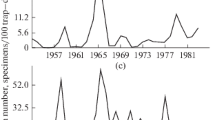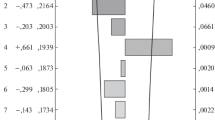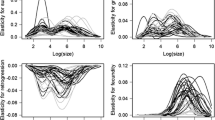Abstract—
An analytical review of our own data and published material accumulated to date on the patterns and factors of the population dynamics of the common shrew (Sorex araneus L.) is presented. It was established that sharp fluctuations in the number are typical for the entire distribution area of this shrew. More or less rhythmic fluctuations were registered only at the optimum of the area. Among exogenous and endogenous factors causing all changes, the height of the snow cover and soil freezing depth in winter; spring temperature conditions and rainfall in the winter–spring period; as well as the population level, status, and ecological structure of the populations in the previous year, are the most significant.
Similar content being viewed by others
REFERENCES
Buckner, C., Some aspects of the population-ecology of the common shrew, Sorex araneus, near Oxford, England, J. Mammalogy, 1969, vol. 50, no. 2, pp. 237–259.
Airapet’yants, A.E., Insectivores and rodents, in Zveri Leningradskoi oblasti (Animals of the Leningrad Oblast), Leningrad: Len. Gos. Univ., 1970, pp. 47–165.
Balakirev, A.E., Okulova, N.M., and Ivanter, E.V., On the analysis of factorial effects on the long-term abundance of the common shrew in the north and south of its range, Povolzh. Ekol. Zh., 2004, no. 2, pp. 111–122.
Beketov, S.V., The secondary sex ratio in mammals, Usp. Sovrem. Biol., 2001, no. 4, pp. 357–377.
Blotskaya, E.S. and Gaiduk, V.E., Populyatsionnaya ekologiya melkikh mlekopitayushchikh (Population Ecology of Small Mammals), Brest: Brest. Gos. Univ., 2004.
Bobretsov, A.V., Insectivores. Muroid Rodents, in Mlekopitayushchie Pechoro-Ilychskogo zapovednika (Mammals of the Pechora-Ilych Nature Reserve), Syktyvkar: Komi Knizhn. Izd., 2004, pp. 38–109.
Bol’shakov, V.N. and Kubantsev, B.S., Polovaya struktura populyatsii mlekopitayushchikh i ee dinamika (Sex Structure of Mammalian Populations and Its Dynamics), Moscow: Nauka, 1984.
Borowski, S. and Dehnel, A., Materialy do biologii Soricidae, Ann. Univ. M. Curie-Sklodowska, 1952, no. 7, pp. 13–21.
Christian, J.J., Population density and reproductive efficiency, Biol. Reprod., 1971, vol. 4, pp. 248–294.
Churchfield, S., Population dynamics and the seasonal fluctuations in numbers of the common shrew in Britain, Acta Theriol., 1980, vol. 25, nos. 32–42, pp. 415–424.
Dokuchaev, N.E., Mechanisms that ensure the restoration of the abundance of shrews of Northeastern Siberia, in X Vsesoyuz. seminar “Biologicheskie problemy Severa”, Tezisy dokladov (X All-Union Workshop “Biological Problems of the North,” Abstract of Papers,), Magadan, 1983, pp. 20–21.
Dokuchaev, N.E., Ekologiya burozubok Severo-Vostochnoi Azii (Ecology of Shrews of Northeast Asia), Moscow: Nauka, 1990.
Dokuchaev, N.E., The structure and productivity of communities of shrews (Insectivora, Soricidae), Zool. Zh., 1994, vol. 73, no. 9, pp. 114–123.
Dokulilova, V. and Suchomel, J., Abundance of common shrew (Sorex araneus) in selected forest habitats of Moravia (Czech Republic), Acta Univ. Agric. Silvic. Mendelianae Brun., 2017, vol. 65, pp. 401–409.
Dolgov, V.A., Chabovskii, V.I., Shilova, S.A., and Efron, K.M., Some problems of ecology of shrews (Soricidae) and their role in TBE foci, Byull. Mosk. O-va Ispyt. Prir., Otd. Biol., 1968, vol. 73, no. 6, pp. 17–28.
Dubrovskii, V.Yu., Long-term dynamics of small mammal population structure in the zonal and intrazonal forest communities of the Moscow oblast, Byull. Mosk. O-va Ispyt. Prir., Otd. Biol., 2002, vol. 107, no. 4, pp. 13–21.
Dunaeva, T.N., On the study of the breeding biology of the common shrew (Sorex araneus), Byull. Mosk. O-va Ispyt. Prir., Otd. Biol., 1995, vol. 60, no. 6, pp. 27–43.
Ermolaeva, E.Z., The spatial distribution and features of fluctuations in abundance of small mammals of Moscow, Extended Abstract of Cand. Sci. (Biol.) Dissertation, Moscow, 2001.
Folitarek, S.S., On the biology of the common shrew (Sorex araneus L.), Zool. Zh., 1940, vol. 19, no. 2, pp. 324–325.
Formozov, A.N., Snezhnyi pokrov kak faktor sredy, ego znachenie v zhizni mlekopitayushchikh i ptits SSSR (Snow Cover as a Protection Factor, Its Importance in the Life of Mammals and Birds of the USSR), Moscow: Mosk. O-vo Ispyt. Prir., 1946.
Formozov, A.N., Small rodents and insectivores of Sharino district of Kostroma oblast in the period 1930–1940, in Materialy po gryzunam (Materials on Rodents), Moscow: Mosk. O-vo Ispyt. Prir., 1948, no. 3, pp. 3–110.
Gaisler, J., Zapieta, L., and Iolisova, V., Mammals of risks in Czechoslovakia, Acta Sc. Nat. Brno, 1967, pp. 154–171.
Hanski, I. and Kaikusalo, A., Distribution and habitat selection of shrews in Finland, Ann. Zool. Fenn., 1989, vol. 26, no. 4, pp. 339–348.
Hanski, I., Food consumption, assimilation and metabolic rate in six species of shrews (Sorex and Neomys), Ann. Zool. Fenn., 1984, vol. 21, pp. 157–165.
Hansson, L., Spring populations of small mammals in central Swedish Lapland in 1964–1968, Oikos, 1969, no. 20, pp. 431–450.
Henttonen, H., Tast, J., Viitala, J., and Kaikusalo, A., Ecology of cyclic rodents in northern Finland, Memoranda Soc. Fauna a. Flora Fennica, 1989, vol. 25, pp. 61–77.
Henttonen, H., Metsien rakenteen muutoksen vaikutuksesta myyrakantoihin ja sita kautta pikkupetoihin ja kanalintuihin, Suomen riista, 1989, vol. 35, pp. 83–90.
Heydemann, B., Zur Okologie von Sorex araneus L. und Sorex minutus L., Z. Saugetierkunde, 1960, vol. 25, nos. 1–2, pp. 164–173.
Ivanter, E.V., Populyatsionnaya ekologiya melkikh mlekopitayushchikh taezhnogo Severo-Zapada SSSR (Population Ecology of Small Mammals of the Taiga North-West of the USSR), Leningrad: Nauka, 1975.
Ivanter, E.V., Teriologiya (Theriology), Petrozavodsk: Petr. Gos. Univ., 2014a.
Ivanter, E.V., Mlekopitayushchie Karelii (Mammals of Karelia), 2nd ed., Petrozavodsk: Petr. Gos. Univ., 2014b.
Ivanter, E.V. and Ivanter, T.V., The common shrew in the Kivach Nature Reserve, in Trudy Gosudarstvennogo Zapovednika “Kivach” (Transactions of the Kivach State Reserve), Petrozavodsk, 1968, no. 1, pp. 115–135.
Ivanter, E.V. and Makarov, A.M., Territorial’naya ekologiya zemleroek-burozubok (Insectivora, Sorex) (Territorial Ecology of Shrews (Insectivora. Sorex)), Petrozavodsk: Petr. Gos. Univ., 2001.
Ivanter, T.V., Ivanter, E.V., and Ternoushko, E.I., Reproduction biology and population struture of shrews (Soricidae) in Karelia, in Voprosy ekologii zhivotnykh (Problems of Animal Ecology), Petrozavodsk, 1974, pp. 95–143.
Ivanter, E.V., Makarov, A.M., and Grishchenko, A.E., Abundance and ecological structure of populations of small mammals of the Ladoga region, Biogeogr. Karel., 2003, no. 3, pp. 89–110.
Ivanter, E.V., Makarov, A.M., and Gorelik, A.N., Experience of statistical analysis of long-term changes in the abundance of the common shrew (Sorex araneus L.) on the northern periphery of the range, Zool. Zh., 2017, vol. 96, no. 7, pp. 739–744.
Kaikusalo, A., Population turnover and wintering of the bank vole, Clethrionomys glareolus (Schreb.), in southern and central Finland, Ann. Zool. Fenn., vol. 9, no. 4, pp. 219–224.
Khodasheva, K.S. and Eliseeva, V.I., Zemleroiki v ekosistemakh Tsentral’noi lesostepi Russkoi ravniny (Shrews in the Central Russian Forest-Steppe Plain Ecosystems), Moscow: Nauka, 1992.
Koshkina, T.V., Comparative ecology of bank voles in northern taiga, in Fauna i ekologiya gryzunov (Fauna and Ecology of Rodents), Moscow, 1957, no. 5, pp. 3–65.
Kupriyanova, I.F., Abundance and biotopic relationships of shrews (Insectivora, Soricidae) in the Arkhangelsk oblast, in Fauna i ekologiya zhivotnykh (Fauna and Ecology of Animals), Moscow: Mosk. Gos. Pedagog. Inst. im. V.I. Lenina, 1976, part 2, pp. 170–184.
Kupriyanova, I.F., Family Soricidae, in Fauna evropeiskogo Severo-Vostoka Rossii. Mlekopitayushchie (Fauna of the European North-East of Russia. Mammals), St. Petersburg: Nauka, 1994, vol. 2, part 1, pp. 11–67.
Kurkhinen, Yu.P., Danilov, P.I., and Ivanter, E.V., Mlekopitayushchie Vostochnoi Fennoskandii v usloviyakh antropogennoi transformatsii taezhnykh ekosistem (Mammals of Eastern Fennoscandia under the Conditions of Anthropogenic Transformation of Boreal Ecosystems), Moscow: Nauka, 2006.
Lavrov, N.P., On the biology of the common shrew (Sorex araneus L.), Zool. Zh., 1943, vol. 2, no. 6, pp. 361–365.
Lavrova, M.Ya., On leptospirosis in small insectivores in Shakhovskoi district of Moscow oblast, Zool. Zh., 1960, vol. 39, no. 7, pp. 74–81.
Lediker, R., On the development of population ecology in the last 40 years, Sib. Ekol. Zh., 1999, no. 1, pp. 84–96.
Lokhmiller, R.L. and Moshkin, M.P., Environmental factors and the adaptive significance of the variability of immunity in small mammals, Sib. Ekol. Zh., 1999, no. 1, pp. 37–58.
Luk’yanova, I.V., The distribution of shrews (Soricidae) in the southern taiga and sub-taiga forests of the Ob region, in Sistematika, fauna, zoogeografiya mlekopitayushchikh i ikh parazitov (Taxonomy, Fauna, and Zoogeography of Mammals and Their Parasites), Novosibirsk, 1975, pp. 70–76.
Maksimov, A.A. and Erdakov, L.N., Tsiklicheskie problemy v soobshchestvakh zhivotnykh (Cyclical Problems in Animal Communities), Novosibirsk: Nauka, 1985.
Mezhzherin, V.A., Features of ecology of shrews (Soricidae) and their population dynamics in the Forest-steppe and Polesie of Ukraine, Extended Abstract of Cand. Sci (Biol.) Dissertation, Kiev, 1961.
Myasnikov, Yu.A., Distribution and fluctuations in the abundance of rodents, lagomorphs, and insectivores of the Tula oblast, in Fauna i ekologiya gryzunov (Fauna and Ecology of Rodents), Moscow: Mosk. Gos. Univ., 1976, non. 13, pp. 164–236.
Okhotina, M. and Nadtochy, E., Effect of Marnmanidula asperocutis Sadovskaja in Skrjabin, Sihobalova et Sole, 1954 (Nematoda), on the population size of shrews of genus Sorex, Acta Parasitol. Polonica, 1970, vol. 18, no. 8, pp. 381–389.
Okhotina, M.V. and Nadtochy, E., The morphoecological features of different species of shrews (Sorex, Insectivora), that determine the possibility of their coexistence, in Fauna i ekologiya nazemnykh pozvonochnykh yuga Dal’nego Vostoka SSSR: Trudy biologopochvennogo instituta (Fauna and Ecology of Terrestrial Vertebrates in the Southern Far East of the USSR: Transactions of the Biological-Soil Institute), Vladivostok, 1974, vol. 17, pp. 42–57.
Okulova, N.M., Biologicheskie vzaimosvyazi v lesnykh ekosistemakh (na primere prirodnykh ochagov kleshchevogo entsefalita) (Biological Relationships in Forest Ecosystems (As Exemplified by the Natural Foci of Tick-Borne Encephalitis)), Moscow: Nauka, 1986.
Panov, V.V and Karpenko, S.V., The population dynamics of the Eurasian water shrew Neomys fodiens (Mammalia: Soricidae) and its helminthofauna in North Baraba, Parazitologiya, 2004, vol. 38, no. 5, pp. 448–456.
Petrov, O.V., Gur’ev, V.N., Dolgien, M.M., Dorovskikh, G.N., Romanov, G.G., and Solov’ev, V.A., Fauna i ekologiya zhivotnykh podzony srednei taigi Komi (The Fauna and Ecology of Animals in the Middle Taiga Subzone of Komi), Syktyvkar, 1986. Deposited at VINITI October 15, 1086, no. 8014-1386.
Petrov, A.N., Small mammals of transformed and nontransformed territories of Eastern European tundras, Extended Abstract of Cand. Sci. (Biol.) Dissertation, Syktyvkar, 2010.
Popov, V.A., Mlekopitayushchie Volzhsko-Kamskogo kraya (Mammals of the Volga–Kama Region), Kazan, 1960.
Popov, V.A., On the problem of biotopic populations, in Prirodnye resursy Volzhsko-Kamskogo kraya. Zhivotnyi mir (Natural Resources of the Volga–Kama Region. Fauna), Kazan, 1968, vol. 2, pp. 45–57.
Popov, M.V., Laxmann’s shrew, Eurasian pygmy shrew, taiga shrew, northern red-backed vole, large-toothed redback vole, field vole, and muroid rodents, in Mlekopitayushchie Yakutii (Mammals of Yakutia), Moscow: Nauka, 1971, pp. 51–71.
Popov, I.Yu., Long-term changes in the abundance of mammals of the southern taiga in the Vetluga region, Zool. Zh., 2000, vol. 79, no. 4, pp. 446–451.
Popov, V.A., Voronov, N.P., and Kulaeva, T.M., Essays on the ecology of shrews (Soricidae) of the Raifa forests (Tatar ASSR), Izv. Kazan. Fil. Akad. Nauk SSSR, Ser. Biol. S.-Kh. Nauk, 1950, no. 2, pp. 173–208.
Puzachenko, Yu.G., Matematicheskie metody v ekologicheskikh i geograficheskikh issledovaniyakh (Mathematical Methods in Ecological and Geographical Studies), Moscow: Akademiya, 2004.
Puzachenko, A.Yu., Vlasov, A.A., and Eliseeva, V.I., Analysis of long-term observations of the dynamics of the abundance of small mammals on the basis of Chronicle of Nature data. Evaluation of abundance dynamics parameters: supplement, Tr. Tsentr.-Chernozem. Gos. Zapov., 1997, no. 15, pp. 12–18.
Reimers, N.F. and Voronov, G.A., Nasekomoyadnye i gryzuny Verkhnei Leny (Insectivores and Rodents of the Upper Lena Region), Irkutsk, 1963.
Sergeev, V.E., Ecology of shrews (Soricidae) of the Ob River floodplain, Extended Abstract of Cand. Sci. (Biol.) Dissertation, Novosibirsk, 1974.
Sergeev, V.E., Il’yashenko, V.B., Onishchenko, S.S., and Kolegova, I.A., Long-term dynamics of the taxocene of shrews of the black taiga of the south of Western Siberia, Sib. Ekol. Zh., 2001, no. 6, pp. 785–790.
Shadrina, E.G., Small mammals of northern taiga of the lower reaches of the Indigirka River, Extended Abstract of Cand. Sci. (Biol.) Dissertation, Novosibirsk, 1994.
Sharova, L.P., Species composition of shrews (family Soricidae) and their distribution in faunal complexes of the Ural and European North, in Issledovanie melkikh mlekopitayushchikh na Urale i Evropeiskom Severe (Studies of Small Mammals in the Urals and European North), Sverdlovsk, 1985, pp. 13–27.
Shchipanov, N.A., Kalinin, A.A., Demidova, T.B., Oleinichenko, V.Y., Aleksandrov, D.Y., and Kouptzov, A.V., Population ecology of red-toothed shrews, Sorex araneus, S. caecutiens, S minutus and S. isoidon in Central Russia, in Advances in the Biology of Shrews II. Special Publ. of the 1 Int. Soc. Shrew Biol., 2005, vol. 1, pp. 201–215.
Sheftel, B.I., Long-term and seasonal dynamics of shrews in Central Siberia, Ann. Zool. Fenn., 1989, vol. 26, no. 4, pp. 357–369.
Sheftel’, B.I., Ecological aspects of the spatiotemporal interspecies relationships between shrews of Central Siberia, Extended Abstract of Cand. Sci. (Biol.) Dissertation, Moscow, 1985.
Shilov, I.A., Ekologo-fiziologicheskie osnovy populyatsionnykh otnoshenii u zhivotnykh (Ecological and Physiological Bases of Population Relations in Animals), Moscow: Mosk. Gos. Univ., 1977.
Shtainlekhner, S. and Pukhal’skii, V., Seasonal regulation of mammalian reproduction, Sib. Ekol. Zh., 1999, no. 1, pp. 23–35.
Shvarts, S.S., Morphological and ecological features of shrews at the extreme and northern boundaries of their distribution, Tr. Inst. Biol. Ural. Fil. Akad. Nauk SSSR, 1962, no. 29, pp. 45–51.
Skaren, U., Fluctuations in small mammals populations in mossy forests of Kuhmo, Eastern Finland, during eleven years, Ann. Zool. Fenn., 1972, vol. 9, no. 3, pp. 147–151.
Snigirevskaya, E.M., Materials on reproduction biology and fluctuations in abundance of shrews in the Bashkir Reserve, Tr. Bashkir. Gos. Zapov., 1947, no. 1, pp. 12–18.
Stadukhin, O.M., On the cyclicity of abundance of rodents and shrews in the Sverdlovsk region of the Urals, in Mlekopitayushchie Ural’skikh gor (Mammals of the Ural Mountains), Sverdlovsk: Ural. Nauchn. Tsentr Akad. Nauk SSSR, 1979, pp. 65–67.
Suchomel, J., Purchart, L., Cepelka, L., and Heroldova, M., Structure and diversity of small mammal communities of mountain forests in western Carpathians, Eur. J. Forest Res., 2014, vol. 133, no. 3, pp. 481–490.
Tkadlec, E. and Zejda, J., Density-dependent life histories in female bank vole fluctuating populations, Okeanologiya, 1988, vol. 67, pp. 863–873.
Tolkachev, O.V., The impact of urbanization on the population of shrews in forest ecosystems, Extended Abstract of Cand. Sci. (Biol.) Dissertation, Yekaterinburg, 2007.
Viktorov, L.V., The results of counts of shrews in the Kalinin oblast (changes in abundance over years and seasons), Uch. Zap. Kalinin. Pedagog. Inst., 1964, vol. 31, pp. 74–99.
Vinogradov, V.V., Long-term dynamics and structure of shrews association (Soricidiae) in the mountain taiga of the Eastern Sayan, Contemp. Probl. Ecol., 2012, vol. 5, no. 1, pp. 97–103.
Voronov, G.A., Geografiya melkikh mlekopitayushchikh yuzhnoi taigi Priural’ya, Srednei Sibiri i Dal’nego Vostoka (antropogennaya dinamika fauny i naseleniya) (Geography of Small Mammals of Southern Taiga of the Cis-Urals, Central Siberia, and the Far East (Anthropogenic Dynamics of the Fauna and the Population)), Perm: Perm. Univ., 1993.
Zakharov, V.M., Sheftel’, B.I., and Dmitriev, S.G., Climate changes and population dynamics: possible consequences (as exemplified by small mammals in Central Siberia), Usp. Sovrem. Biol., 2011, vol. 31, no. 5, pp. 435–439.
Zil’bermints, I.V., Ecology of shrews and their significance in the biocenosis of the lower forest synfolium, Extended Abstract of Cand. Sci. (Biol.) Dissertation, Moscow, 1950.
Zub, K., Jedrejewska, B., Jedrewski, W., and Barton, K.A., Cyclic voles and shrews and mice in a marginal grassland within European temperate forest, Acta Theriol., 2012, vol. 57, no. 3, pp. 205–216.
Author information
Authors and Affiliations
Corresponding author
Ethics declarations
Conflict of interests. The authors declare that they have no conflict of interest.
Statement of the welfare of animals. This article does not contain any studies involving animals performed by any of the authors.
Additional information
Translated by A. Barkhash
Rights and permissions
About this article
Cite this article
Ivanter, E.V. Population Dynamics of the Common Shrew (Sorex araneus) (Experience in an Analytical Review of the State of the Problem). Biol Bull Russ Acad Sci 47, 844–853 (2020). https://doi.org/10.1134/S1062359020070055
Received:
Revised:
Accepted:
Published:
Issue Date:
DOI: https://doi.org/10.1134/S1062359020070055




